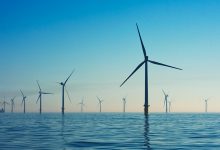More than 200GW worth of new offshore wind projects have been announced around the world since 2020, according to new figures published this week, but regulatory hurdles and supply chain constraints will nevertheless hinder the completion of the entire pipeline by 2030.
The new figures were published this week by renewable energy consultancy The Renewables Consulting Group (RCG) in their 2020 Global Offshore Wind Annual Market Report.
The headline good news reveals that 2020, despite the impact of the global COVID-19 pandemic, was nothing short of spectacular, with 200GW of new offshore wind projects announced since the beginning of 2020.
Total capacity of financed offshore wind projects in 2020 reached 8,370MW across the European, Americas, and Asia Pacific (excl. China) regions, well and truly exceeding the previous record total of 6,438 MW financed in 2018.
Global investment for offshore wind set a new record of $US30 billion, surpassing the previous high of $US22 billion, again set in 2018.
New projects of 500MW or greater were announced n Spain, Ireland, Norway, Taiwan, South Korea, Italy, Brazil, and Vietnam between the beginning of 2020 through to early 2021.
Moreover, floating offshore wind technology continued to emerge during this time as a utility-scale option for markets with deep-water seabed areas where traditional fixed bed concrete foundations are economically and practically impossible.

* Note: Q1 2021 update. Recent project announcements bring the active global portfolio to 510.5 GW
“This year’s Annual Market Report is an invaluable data source and its findings clearly demonstrate that global offshore wind continued to its impressive growth in all sectors during 2020,” said Lee Clarke, COO of RCG.
“With a steady and predictable framework, we continue to see positive developments emanating from emerging markets, such as in the APAC and the Americas regions. The ongoing maturation of technology and declining costs for offtake have inspired governments and investors to embrace offshore wind, with many authorities touting offshore wind as a cornerstone to a green economic recovery in the wake of a global recession.”

However, despite the impressive global growth and uptake of offshore wind development, RCG warns of troubled waters ahead, pointing specifically to supply chain constraints across all regions as well as undefined development frameworks and route to market mechanisms.
Together, these regulatory and supply chain hurdles could significantly limit the ambition of government authorities and investors in completing planned and in-pipeline offshore wind projects.
Looking forward in the figures, RCG expects that the Asia Pacific offshore wind market portfolio will surpass that of the EMEA (Europe, Middle East, and Africa), with the current market leader, the United Kingdom, losing its top spot to both Vietnam and China, respectively, by the end of the year.
While Vietnam might sound an odd choice for surpassing the United Kingdom as the world’s leading offshore wind developer, with a current 99MW worth of inter-tidal capacity, the country nevertheless boasts a massive development pipeline of 64.9GW – with its early-stage development capacity almost entirely comprised of projects proposed under the country’s recent national power development plan.
China, on the other hand, with its existing 8.5GW worth of operational capacity, has another 30.2GW under development, and a total portfolio of 63.6GW.
On the other side of the globe, Brazil saw it’s offshore wind market flourish in 2020, with over 31GW of new projects announces through the year and into 2021.










